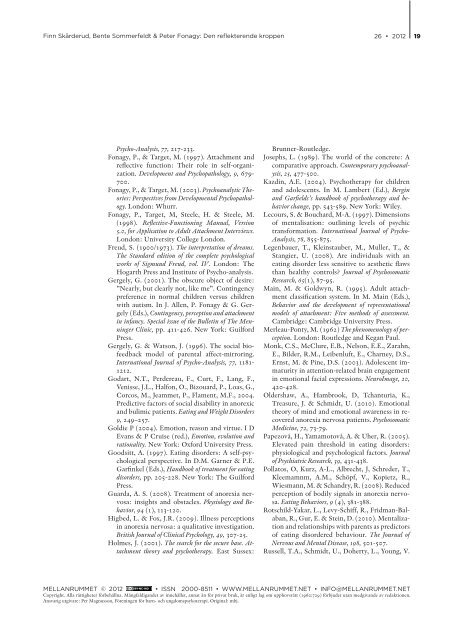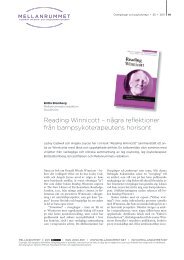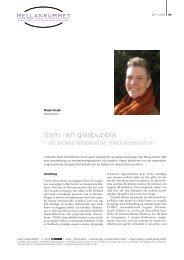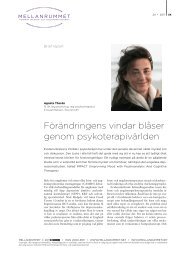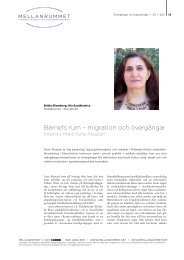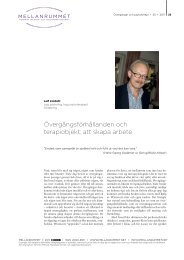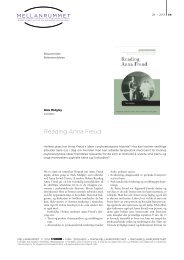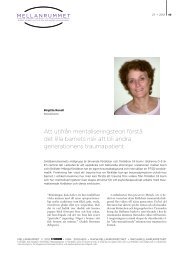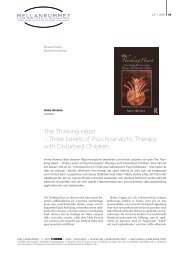Den reflekterende kroppen - Mellanrummet
Den reflekterende kroppen - Mellanrummet
Den reflekterende kroppen - Mellanrummet
You also want an ePaper? Increase the reach of your titles
YUMPU automatically turns print PDFs into web optimized ePapers that Google loves.
Finn Skårderud, Bente Sommerfeldt & Peter Fonagy: <strong>Den</strong> <strong>reflekterende</strong> <strong>kroppen</strong><br />
Psycho-Analysis, 77, 217-233.<br />
Fonagy, P., & Target, M. (1997). Attachment and<br />
reflective function: Their role in self-organization.<br />
Development and Psychopathology, 9, 679-<br />
700.<br />
Fonagy, P., & Target, M. (2003). Psychoanalytic Theories:<br />
Perspectives from Developmental Psychopathology.<br />
London: Whurr.<br />
Fonagy, P., Target, M, Steele, H. & Steele, M.<br />
(1998). Reflective-Functioning Manual, Version<br />
5.0, for Application to Adult Attachment Interviews.<br />
London: University College London.<br />
Freud, S. (1900/1973). The interpretation of dreams.<br />
The Standard edition of the complete psychological<br />
works of Sigmund Freud, vol. IV. London: The<br />
Hogarth Press and Institute of Psycho-analysis.<br />
Gergely, G. (2001). The obscure object of desire:<br />
”Nearly, but clearly not, like me”. Contingency<br />
preference in normal children versus children<br />
with autism. In J. Allen, P. Fonagy & G. Gergely<br />
(Eds.), Contingency, perception and attachment<br />
in infancy. Special issue of the Bulletin of The Menninger<br />
Clinic, pp. 411-426. New York: Guilford<br />
Press.<br />
Gergely, G. & Watson, J. (1996). The social biofeedback<br />
model of parental affect-mirroring.<br />
International Journal of Psycho-Analysis, 77, 1181-<br />
1212.<br />
Godart, N.T., Perdereau, F., Curt, F., Lang, F.,<br />
Venisse, J.L., Halfon, O., Bizouard, P., Loas, G.,<br />
Corcos, M., Jeammet, P., Flament, M.F., 2004.<br />
Predictive factors of social disability in anorexic<br />
and bulimic patients. Eating and Weight Disorders<br />
9, 249–257.<br />
Goldie P (2004). Emotion, reason and virtue. I D<br />
Evans & P Cruise (red.), Emotion, evolution and<br />
rationality. New York: Oxford University Press.<br />
Goodsitt, A. (1997). Eating disorders: A self-psychological<br />
perspective. In D.M. Garner & P.E.<br />
Garfinkel (Eds.), Handbook of treatment for eating<br />
disorders, pp. 205-228. New York: The Guilford<br />
Press.<br />
Guarda, A. S. (2008). Treatment of anorexia nervosa:<br />
insights and obstacles. Physiology and Behavior,<br />
94 (1), 113-120.<br />
Higbed, L. & Fox, J.R. (2009). Illness perceptions<br />
in anorexia nervosa: a qualitative investigation.<br />
British Journal of Clinical Psychology, 49, 307-25.<br />
Holmes, J. (2001). The search for the secure base. Attachment<br />
theory and psychotherapy. East Sussex:<br />
26 • 2012<br />
Brunner-Routledge.<br />
Josephs, L. (1989). The world of the concrete: A<br />
comparative approach. Contemporary psychoanalysis,<br />
25, 477-500.<br />
Kazdin, A.E. (2004). Psychotherapy for children<br />
and adolescents. In M. Lambert (Ed.), Bergin<br />
and Garfields’s handbook of psychotherapy and behavior<br />
change, pp. 543-589. New York: Wiley.<br />
Lecours, S. & Bouchard, M-A. (1997). Dimensions<br />
of mentalisation: outlining levels of psychic<br />
transformation. International Journal of Psycho-<br />
Analysis, 78, 855-875.<br />
Legenbauer, T., Kleinstauber, M., Muller, T., &<br />
Stangier, U. (2008). Are individuals with an<br />
eating disorder less sensitive to aesthetic flaws<br />
than healthy controls? Journal of Psychosomatic<br />
Research, 65(1), 87-95.<br />
Main, M. & Goldwyn, R. (1995). Adult attachment<br />
classification system. In M. Main (Eds.),<br />
Behavior and the development of representational<br />
models of attachment: Five methods of assessment.<br />
Cambridge: Cambridge University Press.<br />
Merleau-Ponty, M. (1962) The phenomenology of perception.<br />
London: Routledge and Kegan Paul.<br />
Monk, C.S., McClure, E.B., Nelson, E.E., Zarahn,<br />
E., Bilder, R.M., Leibenluft, E., Charney, D.S.,<br />
Ernst, M. & Pine, D.S. (2003). Adolescent immaturity<br />
in attention-related brain engagement<br />
in emotional facial expressions. NeuroImage, 20,<br />
420-428.<br />
Oldershaw, A., Hambrook, D, Tchanturia, K.,<br />
Treasure, J. & Schmidt, U. (2010). Emotional<br />
theory of mind and emotional awareness in recovered<br />
anorexia nervosa patients. Psychosomatic<br />
Medicine, 72, 73-79.<br />
Papezová, H., Yamamotová, A. & Uher, R. (2005).<br />
Elevated pain threshold in eating disorders:<br />
physiological and psychological factors. Journal<br />
of Psychiatric Research, 39, 431-438.<br />
Pollatos, O, Kurz, A-L., Albrecht, J, Schreder, T.,<br />
Kleemamnm, A.M., Schöpf, V., Kopietz, R.,<br />
Wiesmann, M. & Schandry, R. (2008). Reduced<br />
perception of bodily signals in anorexia nervosa.<br />
Eating Behaviors, 9 (4), 381-388.<br />
Rotschild-Yakar, L., Levy-Schiff, R., Fridman-Balaban,<br />
R., Gur, E. & Stein, D. (2010). Mentalization<br />
and relationships with parents as predictors<br />
of eating disordered behaviour. The Journal of<br />
Nervous and Mental Disease, 198, 501-507.<br />
Russell, T.A., Schmidt, U., Doherty, L., Young, V.<br />
MELLANRUMMET © 2012 • ISSN 2000-8511 • WWW.MELLANRUMMET.NET • INFO@MELLANRUMMET.NET<br />
Copyright. Alla rättigheter förbehållna. Mångfaldigandet av innehållet, annat än för privat bruk, är enligt lag om upphovsrätt (1960:729) förbjudet utan medgivande av redaktionen.<br />
Ansvarig utgivare: Per Magnusson, Föreningen för barn- och ungdomspsykoterapi. Original: mbj.<br />
19


